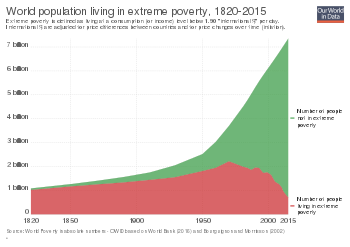
Back الفقر المدقع Arabic Галеча BE Галеча BE-X-OLD Pobresa extrema Catalan Extrémní chudoba Czech Absolute Armut German Pobreza extrema Spanish فقر مطلق FA Äärimmäinen köyhyys Finnish Extrême pauvreté French
This article has multiple issues. Please help improve it or discuss these issues on the talk page. (Learn how and when to remove these messages)
|



Extreme poverty[a] is the most severe type of poverty, defined by the United Nations (UN) as "a condition characterized by severe deprivation of basic human needs, including food, safe drinking water, sanitation facilities, health, shelter, education and information. It depends not only on income but also on access to services".[1] Historically, other definitions have been proposed within the United Nations.
In 2018, extreme poverty mainly refers to an income below the international poverty line of $1.90 per day (in 2011 prices, $2.57 in 2023 dollars),[2] set by the World Bank. In October 2017, the World Bank updated the international poverty line, a global absolute minimum, to $1.90 a day.[3] This is the equivalent of $1.00 a day in 1996 US prices, hence the widely used expression "living on less than a dollar a day".[4] The vast majority of those in extreme poverty reside in South Asia and Sub-Saharan Africa. As of 2018, it is estimated that the country with the most people living in extreme poverty is Nigeria, at 86 million.[5][6][7]
In the past, the vast majority of the world population lived in conditions of extreme poverty.[8][9] The percentage of the global population living in absolute poverty fell from over 80% in 1800 to under 20% by 2015.[10] According to UN estimates, in 2015[update] roughly 734 million people or 10% remained under those conditions.[11] The number had previously been measured as 1.9 billion in 1990, and 1.2 billion in 2008. Despite the significant number of individuals still below the international poverty line, these figures represent significant progress for the international community, as they reflect a decrease of more than one billion people over 15 years.[11]
In public opinion surveys around the globe, people surveyed tend to think that extreme poverty has not decreased.[12][13]
The reduction of extreme poverty and hunger was the first Millennium Development Goal (MDG1), as set by the United Nations in 2000. Specifically, the target was to reduce the extreme poverty rate by half by 2015, a goal that was met five years ahead of schedule.[14] In the Sustainable Development Goals, which succeeded the MDGs, the goal is to end extreme poverty in all its forms everywhere. With this declaration the international community, including the UN and the World Bank have adopted the target of ending extreme poverty by 2030.
Cite error: There are <ref group=lower-alpha> tags or {{efn}} templates on this page, but the references will not show without a {{reflist|group=lower-alpha}} template or {{notelist}} template (see the help page).
- ^ United Nations. "Report of the World Summit for Social Development", 6–12 March 1995. (archived from the original on 4 July 2019)
- ^ 1634–1699: McCusker, J. J. (1997). How Much Is That in Real Money? A Historical Price Index for Use as a Deflator of Money Values in the Economy of the United States: Addenda et Corrigenda (PDF). American Antiquarian Society. 1700–1799: McCusker, J. J. (1992). How Much Is That in Real Money? A Historical Price Index for Use as a Deflator of Money Values in the Economy of the United States (PDF). American Antiquarian Society. 1800–present: Federal Reserve Bank of Minneapolis. "Consumer Price Index (estimate) 1800–". Retrieved 29 February 2024.
- ^ "Principles and Practice in Measuring Global Poverty". The World Bank. 13 January 2016. Retrieved 17 June 2019.
- ^ "Overview". World Bank. Retrieved 17 December 2019.
- ^ Laurence Chandy and Homi Kharas (2014), What Do New Price Data Mean for the Goal of Ending Extreme Poverty?, Brookings Institution, Washington, DC. Article was reviewed in The Financial Times: Shawn Donnan (9 May 2014), World Bank eyes biggest global poverty line increase in decades
- ^ "India no longer home to the largest number of poor: Study". Time of India. 27 June 2018. Retrieved 21 July 2018.
- ^ "The start of a new poverty narrative". 19 June 2018. Retrieved 21 July 2018.
- ^ "About the book". Economics & Poverty. 1 December 2015. Retrieved 10 March 2019.
- ^ Zanden, Jan Luiten van; Baten, Joerg; Foldvari, Peter; Leeuwen, Bas van (July 2011). "The Changing Shape of Global Inequality – exploring a new dataset". Working Papers.
- ^ Beauchamp, Zach (14 December 2014). "The world's victory over extreme poverty, in one chart". Vox. Retrieved 17 June 2019.
- ^ a b "PovcalNet". iresearch.worldbank.org. Retrieved 10 March 2019.
- ^ Human Progress, "What 19 in 20 Americans Don't Know About World Poverty," 30 April 2018
- ^ Rosling, Hans; Rönnlund, Anna Rosling; Rosling, Ola (3 April 2018). Factfulness: Ten Reasons We're Wrong About the World – and Why Things Are Better Than You Think. Flatiron Books. p. 7. ISBN 9781250123817.
- ^ Cite error: The named reference
:0was invoked but never defined (see the help page).